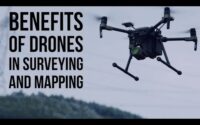The Evolving Role of Drones in Kremlin’s Strategy
Drones play a crucial role in the Kremlin’s military strategy, enhancing surveillance and offensive capabilities. The proliferation of drone technology has led to an arms race, with the Kremlin investing in research and development. The Kremlin also recognizes the economic potential of drones in non-military sectors and supports their implementation.
Drones and the Kremlin: A Complex Relationship Shaping International Dynamics
Firstly, drones have become an integral part of the Kremlin’s military strategy, enhancing its surveillance and reconnaissance capabilities. By utilizing drones, the Kremlin can gather crucial intelligence, monitor borders, and identify potential threats more effectively.
Secondly, the Kremlin has also been deploying drones for offensive purposes, conducting airstrikes and targeted assassinations. These actions have generated controversy and raised concerns among international actors regarding the Kremlin’s use of unmanned aerial vehicles (UAVs) as a means of exerting power and influence.
Furthermore, the proliferation of drone technology has led to an arms race, with both state and non-state actors seeking to enhance their drone capabilities. The Kremlin, recognizing the strategic importance of drones, has invested in research and development to advance its UAV capabilities and maintain a competitive edge.
On the other hand, the Kremlin has been wary of the implications of drones in the hands of adversaries. It has expressed concerns about the potential use of drones for surveillance and intelligence gathering against its own interests, especially by Western nations. This has prompted the Kremlin to develop countermeasures to mitigate the threat posed by hostile drone activities.
The relationship between drones and the Kremlin is not only limited to military applications. Drones have also found utility in non-military sectors, such as agriculture, transportation, and infrastructure development. The Kremlin has recognized the economic potential of drone technology and has actively supported its implementation in various industries.
However, the use of drones in non-military contexts also presents challenges for the Kremlin. It has had to address concerns related to privacy, regulation, and safety, as the increasing prevalence of drones raises issues regarding airspace control and potential misuse.
Drones: Revolutionizing Modern Warfare
Drones have undeniably revolutionized modern warfare, offering unprecedented capabilities and strategic advantages on the battlefield. From surveillance to combat operations, these unmanned aerial vehicles have transformed the way military forces operate. One noteworthy example of this is the utilization of drones by the Kremlin.
The Kremlin, known for its military prowess and innovative approach, has fully embraced drone technology to enhance its military capabilities. Drones have provided the Russian armed forces with a range of benefits, enabling them to gather intelligence, conduct reconnaissance missions, and carry out precision strikes with remarkable accuracy.
Through the strategic deployment of drones, the Kremlin has obtained valuable real-time information on enemy movements, facilitating effective decision-making and operational planning. Drones equipped with high-resolution cameras and advanced sensors have allowed Russian forces to closely monitor hostile territories, providing critical insights without putting human lives at risk.
Furthermore, the Kremlin has leveraged drones for precision strikes, significantly increasing the accuracy and efficiency of its military operations. Equipped with guided missiles and bombs, these unmanned aircraft can precisely target enemy positions, infrastructure, and high-value targets. By employing drones, the Kremlin has minimized collateral damage and reduced the risk of casualties among its own troops.
Moreover, the versatility of drones enables the Kremlin to adapt to different battlefield scenarios swiftly. Drones can be quickly deployed to support ground forces, provide aerial support, or carry out independent missions. This flexibility grants the Russian military a dynamic edge, allowing them to respond rapidly to evolving threats and changing circumstances.
However, the increasing reliance on drones in modern warfare raises ethical concerns and challenges. The potential for civilian casualties, the erosion of privacy, and the risk of autonomous drones becoming weapons of mass destruction are significant issues that need to be addressed. Striking the right balance between utilizing drone technology for military purposes while upholding ethical standards remains a complex challenge for nations around the world.
Security and Surveillance: Kremlin’s Drone Capabilities
The Kremlin has significantly enhanced its surveillance capabilities through the utilization of advanced drone technology. These unmanned aerial vehicles (UAVs) have become integral tools for the Russian government in various security-related operations.
Equipped with state-of-the-art sensors and cameras, Kremlin drones possess remarkable surveillance capabilities. They can capture high-resolution images and videos, allowing for detailed monitoring and analysis of targeted areas. Additionally, these drones often employ advanced image recognition algorithms, enabling them to identify specific objects or individuals of interest.
The Kremlin’s drone fleet consists of a diverse range of UAV models, each serving specific purposes. Some drones are designed for long-range reconnaissance, capable of conducting surveillance over vast territories. Others are equipped with powerful zoom lenses, allowing for precise and discreet surveillance from a distance.
These drones are not limited to traditional surveillance methods alone. They also possess the ability to intercept and collect electronic signals, providing the Kremlin with valuable intelligence on communications and potential threats. This electronic warfare capability gives them an edge in countering adversarial activities.
Furthermore, the Kremlin’s drones exhibit impressive flight capabilities. They can operate in various weather conditions and maneuver through complex terrains, making them versatile assets for both urban and rural surveillance. Their agility and speed allow for swift responses to changing situations, ensuring effective monitoring and response capabilities.
Despite the advantages they offer, Kremlin drones have raised concerns among privacy advocates and foreign governments. The potential for misuse or invasion of privacy is a significant ethical dilemma associated with their widespread deployment. Moreover, their presence in international airspace has sparked tensions and disputes, as other countries perceive them as a potential threat to their sovereignty.
Military Application: Drone Warfare in Russian Strategy
In recent years, drone warfare has become a prominent aspect of Russia’s military strategy, with the Kremlin actively utilizing drones for various purposes. Drones offer significant advantages in terms of surveillance, reconnaissance, and offensive capabilities.
The Russian military employs a range of drones, from small tactical ones to larger, more sophisticated models, to achieve its strategic objectives. These unmanned aerial vehicles (UAVs) are integrated into Russian military operations, providing valuable intelligence and enhancing the effectiveness of their armed forces.
One key application of drones in Russian strategy is their use for surveillance and reconnaissance missions. Drones equipped with advanced sensors and cameras enable the Kremlin to gather real-time information on enemy positions, troop movements, and potential threats. This intelligence helps Russian forces to plan and execute their operations with greater precision and situational awareness.
Furthermore, drones have proven to be valuable assets in offensive operations. Armed drones, commonly known as unmanned combat aerial vehicles (UCAVs), are capable of carrying out targeted airstrikes and engaging enemy targets. By deploying UCAVs, Russia can project power in contested areas without risking the lives of its personnel. This capability enhances their operational flexibility and allows for precise and lethal strikes.
The integration of drones into Russian military strategy also includes the use of swarming tactics. By coordinating multiple drones in a swarm, the Kremlin can overwhelm enemy defenses and disrupt their operations. Swarming drones can perform various tasks simultaneously, such as surveillance, jamming enemy communications, and even launching coordinated attacks. This capability presents a significant challenge for adversaries attempting to defend against such tactics.
However, the increasing reliance on drone warfare also poses challenges for Russia. Adversaries have been developing countermeasures to detect, track, and neutralize drones. Anti-drone technologies, such as electronic jammers and anti-aircraft systems, aim to mitigate the threat posed by drones. Therefore, the Kremlin must continuously adapt its drone technology to stay ahead of these countermeasures and maintain its operational advantage.
Diplomatic Ramifications: Drones and International Relations
Drones have become a significant element in contemporary international relations, raising various diplomatic concerns. One notable example is the relationship between drones and the Kremlin, which has implications for global politics.
- Drones: A Technological Game-Changer
Drones have revolutionized warfare and intelligence gathering, making them valuable assets for governments worldwide. The Kremlin recognizes the strategic advantages of drones in terms of surveillance, reconnaissance, and even targeted strikes.
- Escalation and Provocation
The use of drones by the Kremlin has raised concerns about potential escalation and provocation in international relations. Unmanned aerial vehicles can easily penetrate borders, violating sovereignty and causing tensions between states.
- Violation of International Norms
The Kremlin’s drone activities have sometimes violated international norms and treaties, such as the prohibition of unauthorized surveillance or attacks on foreign soil. Such actions undermine trust and cooperation among nations.
- Attribution Challenges
One of the key diplomatic challenges associated with drones is the issue of attribution. Drones provide a level of anonymity, making it difficult to determine the responsible party in case of an incident. This ambiguity complicates diplomatic discussions and potential retaliatory measures.
- Arms Race and Proliferation
The Kremlin’s investment in drone technology has prompted concerns about an arms race and proliferation. As drones become more accessible, other nations may seek to acquire similar capabilities, leading to an increased risk of conflict and instability.
- Transparency and Confidence-Building Measures
To address the diplomatic ramifications of drones, transparency and confidence-building measures are crucial. International agreements and protocols can enhance transparency in drone operations, ensuring responsible and accountable use.
- Multilateral Dialogue and Cooperation
Engaging in multilateral dialogue and cooperation is essential for managing the diplomatic challenges associated with drones. Nations must work together to establish norms, rules, and mechanisms for addressing drone-related incidents and disputes.
- Future Implications
As drone technology continues to advance, its impact on international relations will likely intensify. Governments must proactively anticipate and address the diplomatic ramifications of drones to maintain stability and promote peaceful relations.
Countering the Threat: Responses to Kremlin’s Drone Technology
In recent years, the Kremlin’s utilization of drone technology has emerged as a significant concern. These unmanned aerial vehicles (UAVs) pose various threats to national security, making it crucial to develop effective countermeasures. Several approaches can be adopted to address this issue.
Firstly, enhancing detection capabilities is paramount. Advanced radar systems and surveillance technologies can aid in identifying and tracking unauthorized drones. By promptly detecting these devices, authorities can swiftly respond and prevent potential threats.
Secondly, the development of anti-drone systems should be prioritized. These systems encompass various methods, such as signal jamming, radio frequency disruption, and GPS spoofing, to neutralize or disable hostile drones. Investing in research and development of such technologies can significantly bolster defense against Kremlin’s drone activities.
Additionally, collaboration among nations is vital to combat this growing threat. Sharing intelligence, best practices, and lessons learned can foster a collective response to counter Kremlin’s drone technology effectively. International agreements and partnerships can facilitate information exchange and joint efforts to develop comprehensive counter-strategies.
Furthermore, training security personnel is crucial. Equipping law enforcement agencies and military forces with the necessary skills to identify, monitor, and respond to rogue drones is essential. Specialized training programs can ensure a swift and effective response to potential drone threats, minimizing their impact.
Public awareness and education campaigns play a pivotal role in countering the Kremlin’s drone technology. Educating the public about the risks associated with drones, emphasizing the importance of reporting suspicious activities, and providing guidelines on personal privacy protection can foster a more vigilant society.
Lastly, research and innovation should continuously drive countermeasures. As drone technology evolves rapidly, investing in research and development of cutting-edge solutions is vital. Collaboration between government institutions, private sector entities, and academic institutions can yield innovative techniques to address emerging challenges posed by Kremlin’s drones.
Ethical and Legal Considerations
Drones have emerged as powerful tools for various applications, including surveillance and reconnaissance. However, their use in sensitive areas such as the Kremlin raises significant ethical and legal concerns. Let’s delve into some key considerations:
Privacy and Surveillance: Drones equipped with cameras can capture detailed imagery, potentially infringing upon individuals’ privacy rights. Balancing security needs with privacy concerns is crucial.
-
National Security: The Kremlin, being the symbol of political power in Russia, demands strict protection. Unauthorized drone flights near this area could pose risks to national security, requiring regulations to safeguard against potential threats.
-
Airspace Regulations: Drone operators must comply with airspace regulations, ensuring safe operation and preventing interference with other aircraft. Designated no-fly zones, including the Kremlin area, should be clearly demarcated and enforced.
-
Unauthorized Intrusion: Unauthorized drones hovering around the Kremlin could disrupt official activities or even pose physical risks. Stringent measures are necessary to prevent unauthorized access to restricted areas.
-
Data Security and Cyber Threats: Drones collecting sensitive data around the Kremlin can be vulnerable to hacking or data breaches. Adequate encryption and secure communication protocols are essential to protect classified information.
-
Geopolitical Implications: If foreign entities operate drones near the Kremlin, it may raise diplomatic tensions and be viewed as a breach of sovereignty. International agreements and cooperation frameworks can help address these concerns.
-
Accountability and Liability: Determining accountability for any incidents involving drones near the Kremlin is crucial. Clear guidelines for operator responsibilities and liability should be established to ensure appropriate action can be taken in case of misconduct.
-
Ethical Use of Force: If armed drones are deployed near the Kremlin, strict adherence to international humanitarian law and rules of engagement must be ensured. The ethical use of force requires well-defined protocols to prevent civilian casualties.
-
Public Perception and Trust: Drone operations near the Kremlin can influence public opinion. Transparent communication about the purpose and scope of drone activities, as well as their compliance with ethical standards, can help maintain public trust.
The Future of Drones: Implications for the Kremlin
Drones have revolutionized various industries, and their impact on national security cannot be overlooked. The Kremlin, as the center of power in Russia, must carefully consider the implications of drone technology for its own interests and national defense.
Firstly, drones provide enhanced surveillance capabilities, enabling advanced intelligence gathering and reconnaissance. The Kremlin must adapt its defense strategies to counteract potential vulnerabilities, as drones can easily breach restricted airspace and collect sensitive information.
Furthermore, drones have transformed the dynamics of warfare. Armed drones possess lethal capabilities, allowing for precise strikes and reducing the need for deploying ground forces. The Kremlin should invest in counter-drone systems to protect its critical infrastructure and military installations from potential attacks.
The commercial use of drones also raises concerns for the Kremlin. Delivery drones, for instance, could be utilized for smuggling or surveillance purposes. Implementing regulations to monitor and control drone operations becomes imperative to maintain security and prevent illicit activities.
Moreover, the rapid advancement of autonomous drones poses a significant challenge. The Kremlin must develop strategies to counter autonomous drones’ potential threat to national security, as they could be employed by hostile actors to carry out coordinated attacks without human intervention.
On the other hand, the Kremlin can leverage drone technology to its advantage. Drones can augment traditional military capabilities, providing increased situational awareness and facilitating quick response times. The Kremlin should explore incorporating drones into its defense infrastructure to enhance its military capabilities.
Additionally, drones can aid in disaster management and emergency response. By utilizing drones equipped with sensors and cameras, the Kremlin can efficiently assess and respond to natural disasters or incidents, improving overall crisis management.
However, the Kremlin must also address the ethical and legal implications of drone usage. Striking the right balance between security and privacy is crucial to avoid infringing upon citizens’ rights while ensuring national security.



